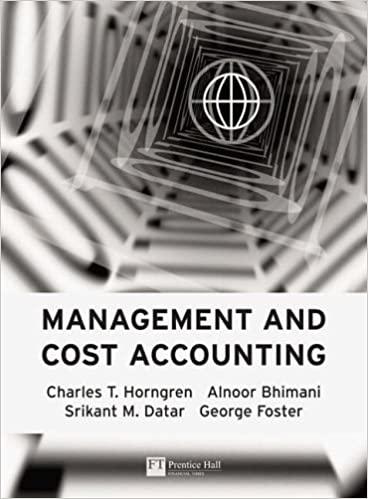Answered step by step
Verified Expert Solution
Question
1 Approved Answer
Question 10 please? . > Data View(Data) > #Question 1 > age summary (age) Min. 1st Qu. Median Mean 3rd Qu. Max. 15.00 30.00 40.00
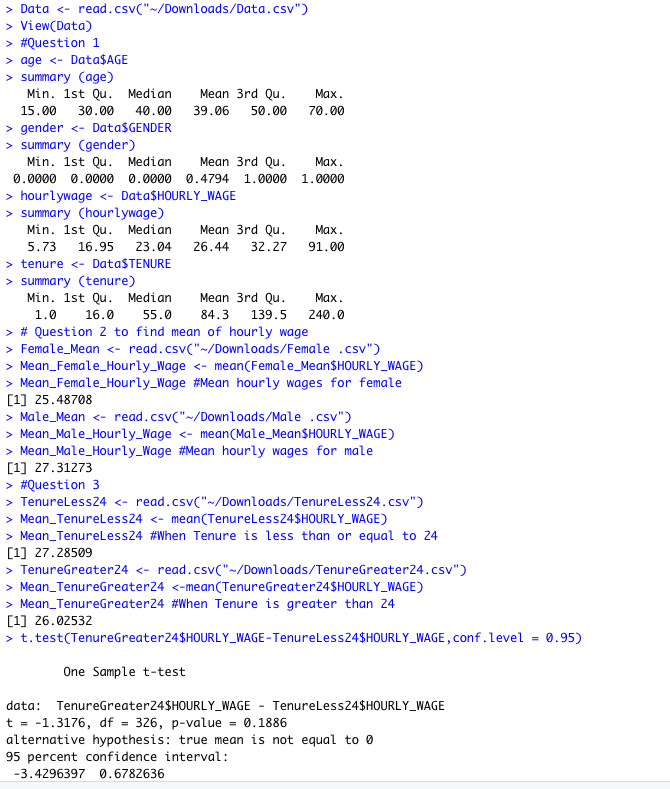
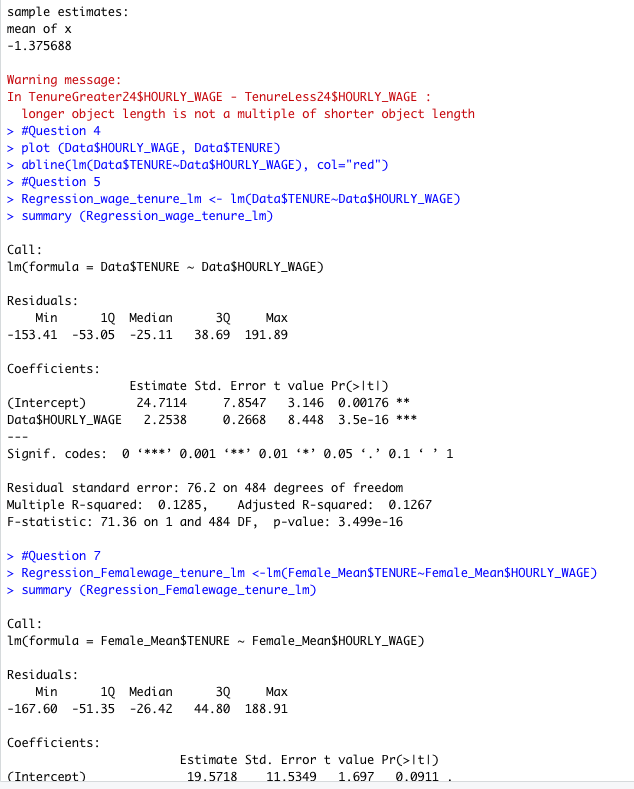
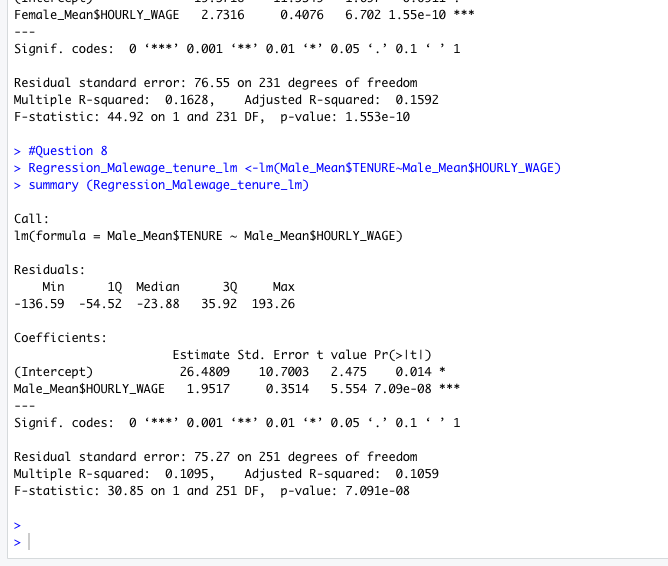
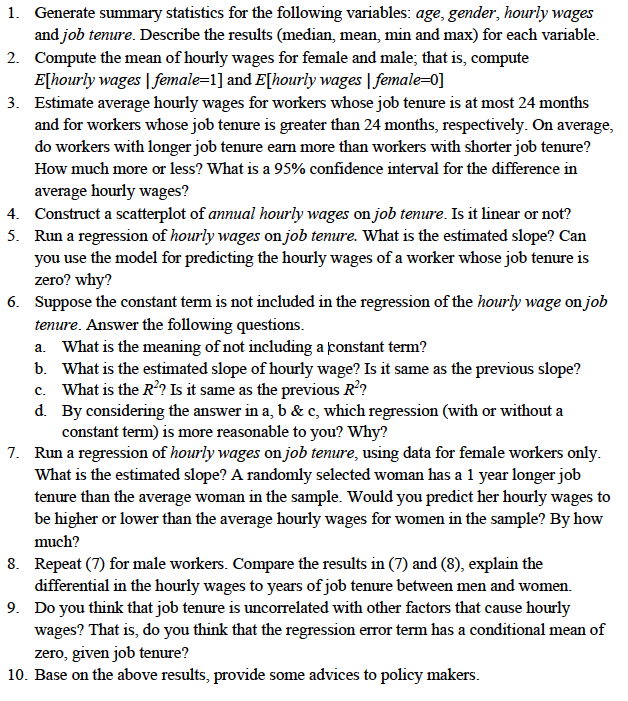
Question 10 please?
. > Data View(Data) > #Question 1 > age summary (age) Min. 1st Qu. Median Mean 3rd Qu. Max. 15.00 30.00 40.00 39.06 50.00 70.00 gender summary (gender) Min. 1st Qu. Median Mean 3rd Qu. Max. 0.0000 0.0000 0.0000 0.4794 1.0000 1.0000 > hourlywage summary Chourlywage) Min. 1st Qu. Median Mean 3rd Qu. . 5.73 16.95 23.04 26.44 32.27 91.00 > tenure summary (tenure) Min. 1st Qu. Median Mean 3rd Qu. 1.0 16.0 55.0 84.3 139.5 240.0 > # Question 2 to find mean of hourly wage > Female_Mean Mean_Female_Hourly_Wage Mean_Female_Hourly_Wage #Mean hourly wages for female [1] 25.48708 > Male_Mean Mean_Male_Hourly_Wage Mean_Male_Hourly_Wage #Mean hourly wages for male [1] 27.31273 > #Question 3 > TenureLess24 Mean_TenureLess24 Mean_Tenureless24 #When Tenure is less than or equal to 24 [1] 27.28509 > TenureGreater24 Mean_TenureGreater24 Mean_TenureGreater24 #When Tenure is greater than 24 [1] 26.02532 > t.test(TenureGreater24$HOURLY_WAGE-TenureLess24$HOURLY_WAGE, conf.level = 0.95) One Sample t-test data: TenureGreater24$HOURLY_WAGE - TenureLess24$HOURLY_WAGE t = -1.3176, df = 326, p-value = 0.1886 alternative hypothesis: true mean is not equal to O 95 percent confidence interval: -3.4296397 0.6782636 sample estimates: mean of x -1.375688 Warning message: In TenureGreater24$HOURLY_WAGE - TenureLess24$HOURLY_WAGE : longer object length is not a multiple of shorter object length > #Question 4 > plot (Data$HOURLY_WAGE, Data$TENURE) > abline(Im(Data$TENURE-Data$HOURLY_WAGE), col="red") > #Question 5 > Regression_wage_tenure_lm summary (Regression_wage_tenure_lm) Call: lm(formula = Data$TENURE Data$HOURLY_WAGE) Residuals: Min 1Q Median -153.41 -53.05 -25.11 30 Max 38.69 191.89 Coefficients: (Intercept) Data$HOURLY_WAGE Estimate Std. Error t value Pr(>It) 24.7114 7.8547 3.146 0.00176 ** 2.2538 0.2668 8.448 3.5e-16 *** Signif. codes: 0 ****' 0.001 ***' 0.01 "*' 0.05.' 0.1 1 1 Residual standard error: 76.2 on 484 degrees of freedom Multiple R-squared: 0.1285, Adjusted R-squared: 0.1267 F-statistic: 71.36 on 1 and 484 DF, p-value: 3.499e-16 > #Question 7 > Regression_Femalewage_tenure_lm summary (Regression_Femalewage_tenure_lm) Call: Im(formula - Female_Mean$TENURE Female_Mean$HOURLY_WAGE) Residuals: Min 1Q Median -167.60 -51.35 -26.42 30 44.80 Max 188.91 Coefficients: Estimate Std. Error t value Pr(>It) 19.5718 11.5349 1.697 0.0911 (Intercept) Female_Mean$HOURLY_WAGE 2.7316 0.4076 6.702 1.55e-10 *** Signif. codes: 0.001 0.01 ** 0.05 1' 0.1 6 1 Residual standard error: 76.55 on 231 degrees of freedom Multiple R-squared: 0.1628, Adjusted R-squared: 0.1592 F-statistic: 44.92 on 1 and 231 DF, p-value: 1.553e-10 > #Question 8 > Regression_Malewage_tenure_lm summary (Regression_Malewage_tenure_lm) Call: Im formula Male_Mean$TENURE Male_Mean$HOURLY_WAGE) Residuals: Min 1Q Median -136.59 -54.52 -23.88 3Q Max 35.92 193.26 Coefficients: (Intercept) Male_Mean$HOURLY_WAGE Estimate Std. Error t value Pr>It) 26.4809 10.7003 2.475 0.014 * 1.9517 0.3514 5.554 7.09e-08 *** Signif. codes: ****' 0.001 ***' 0.01 **' 0.05.' 0.1 1 Residual standard error: 75.27 on 251 degrees of freedom Multiple R-squared: 0.1095, Adjusted R-squared: 0.1059 F-statistic: 30.85 on 1 and 251 DF, p-value: 7.091e-08 AA 1. Generate summary statistics for the following variables: age, gender, hourly wages and job tenure. Describe the results (median, mean, min and max) for each variable. 2. Compute the mean of hourly wages for female and male; that is, compute E[hourly wages | female=1] and E[hourly wages | female=0] 3. Estimate average hourly wages for workers whose job tenure is at most 24 months and for workers whose job tenure is greater than 24 months, respectively. On average, do workers with longer job tenure earn more than workers with shorter job tenure? How much more or less? What is a 95% confidence interval for the difference in average hourly wages? 4. Construct a scatterplot of annual hourly wages on job tenure. Is it linear or not? 5. Run a regression of hourly wages on job tenure. What is the estimated slope? Can you use the model for predicting the hourly wages of a worker whose job tenure is zero? why? 6. Suppose the constant term is not included in the regression of the hourly wage on job tenure. Answer the following questions. a. What is the meaning of not including a constant term? b. What is the estimated slope of hourly wage? Is it same as the previous slope? C. What is the R? Is it same as the previous R? d. By considering the answer in a, b & c, which regression (with or without a constant term) is more reasonable to you? Why? 7. Run a regression of hourly wages on job tenure, using data for female workers only. What is the estimated slope? A randomly selected woman has a 1 year longer job tenure than the average woman in the sample. Would you predict her hourly wages to be higher or lower than the average hourly wages for women in the sample? By how much? 8. Repeat (7) for male workers. Compare the results in (7) and (8), explain the differential in the hourly wages to years of job tenure between men and women. 9. Do you think that job tenure is uncorrelated with other factors that cause hourly wages? That is, do you think that the regression error term has a conditional mean of zero, given job tenure? 10. Base on the above results, provide some advices to policy makers. . > Data View(Data) > #Question 1 > age summary (age) Min. 1st Qu. Median Mean 3rd Qu. Max. 15.00 30.00 40.00 39.06 50.00 70.00 gender summary (gender) Min. 1st Qu. Median Mean 3rd Qu. Max. 0.0000 0.0000 0.0000 0.4794 1.0000 1.0000 > hourlywage summary Chourlywage) Min. 1st Qu. Median Mean 3rd Qu. . 5.73 16.95 23.04 26.44 32.27 91.00 > tenure summary (tenure) Min. 1st Qu. Median Mean 3rd Qu. 1.0 16.0 55.0 84.3 139.5 240.0 > # Question 2 to find mean of hourly wage > Female_Mean Mean_Female_Hourly_Wage Mean_Female_Hourly_Wage #Mean hourly wages for female [1] 25.48708 > Male_Mean Mean_Male_Hourly_Wage Mean_Male_Hourly_Wage #Mean hourly wages for male [1] 27.31273 > #Question 3 > TenureLess24 Mean_TenureLess24 Mean_Tenureless24 #When Tenure is less than or equal to 24 [1] 27.28509 > TenureGreater24 Mean_TenureGreater24 Mean_TenureGreater24 #When Tenure is greater than 24 [1] 26.02532 > t.test(TenureGreater24$HOURLY_WAGE-TenureLess24$HOURLY_WAGE, conf.level = 0.95) One Sample t-test data: TenureGreater24$HOURLY_WAGE - TenureLess24$HOURLY_WAGE t = -1.3176, df = 326, p-value = 0.1886 alternative hypothesis: true mean is not equal to O 95 percent confidence interval: -3.4296397 0.6782636 sample estimates: mean of x -1.375688 Warning message: In TenureGreater24$HOURLY_WAGE - TenureLess24$HOURLY_WAGE : longer object length is not a multiple of shorter object length > #Question 4 > plot (Data$HOURLY_WAGE, Data$TENURE) > abline(Im(Data$TENURE-Data$HOURLY_WAGE), col="red") > #Question 5 > Regression_wage_tenure_lm summary (Regression_wage_tenure_lm) Call: lm(formula = Data$TENURE Data$HOURLY_WAGE) Residuals: Min 1Q Median -153.41 -53.05 -25.11 30 Max 38.69 191.89 Coefficients: (Intercept) Data$HOURLY_WAGE Estimate Std. Error t value Pr(>It) 24.7114 7.8547 3.146 0.00176 ** 2.2538 0.2668 8.448 3.5e-16 *** Signif. codes: 0 ****' 0.001 ***' 0.01 "*' 0.05.' 0.1 1 1 Residual standard error: 76.2 on 484 degrees of freedom Multiple R-squared: 0.1285, Adjusted R-squared: 0.1267 F-statistic: 71.36 on 1 and 484 DF, p-value: 3.499e-16 > #Question 7 > Regression_Femalewage_tenure_lm summary (Regression_Femalewage_tenure_lm) Call: Im(formula - Female_Mean$TENURE Female_Mean$HOURLY_WAGE) Residuals: Min 1Q Median -167.60 -51.35 -26.42 30 44.80 Max 188.91 Coefficients: Estimate Std. Error t value Pr(>It) 19.5718 11.5349 1.697 0.0911 (Intercept) Female_Mean$HOURLY_WAGE 2.7316 0.4076 6.702 1.55e-10 *** Signif. codes: 0.001 0.01 ** 0.05 1' 0.1 6 1 Residual standard error: 76.55 on 231 degrees of freedom Multiple R-squared: 0.1628, Adjusted R-squared: 0.1592 F-statistic: 44.92 on 1 and 231 DF, p-value: 1.553e-10 > #Question 8 > Regression_Malewage_tenure_lm summary (Regression_Malewage_tenure_lm) Call: Im formula Male_Mean$TENURE Male_Mean$HOURLY_WAGE) Residuals: Min 1Q Median -136.59 -54.52 -23.88 3Q Max 35.92 193.26 Coefficients: (Intercept) Male_Mean$HOURLY_WAGE Estimate Std. Error t value Pr>It) 26.4809 10.7003 2.475 0.014 * 1.9517 0.3514 5.554 7.09e-08 *** Signif. codes: ****' 0.001 ***' 0.01 **' 0.05.' 0.1 1 Residual standard error: 75.27 on 251 degrees of freedom Multiple R-squared: 0.1095, Adjusted R-squared: 0.1059 F-statistic: 30.85 on 1 and 251 DF, p-value: 7.091e-08 AA 1. Generate summary statistics for the following variables: age, gender, hourly wages and job tenure. Describe the results (median, mean, min and max) for each variable. 2. Compute the mean of hourly wages for female and male; that is, compute E[hourly wages | female=1] and E[hourly wages | female=0] 3. Estimate average hourly wages for workers whose job tenure is at most 24 months and for workers whose job tenure is greater than 24 months, respectively. On average, do workers with longer job tenure earn more than workers with shorter job tenure? How much more or less? What is a 95% confidence interval for the difference in average hourly wages? 4. Construct a scatterplot of annual hourly wages on job tenure. Is it linear or not? 5. Run a regression of hourly wages on job tenure. What is the estimated slope? Can you use the model for predicting the hourly wages of a worker whose job tenure is zero? why? 6. Suppose the constant term is not included in the regression of the hourly wage on job tenure. Answer the following questions. a. What is the meaning of not including a constant term? b. What is the estimated slope of hourly wage? Is it same as the previous slope? C. What is the R? Is it same as the previous R? d. By considering the answer in a, b & c, which regression (with or without a constant term) is more reasonable to you? Why? 7. Run a regression of hourly wages on job tenure, using data for female workers only. What is the estimated slope? A randomly selected woman has a 1 year longer job tenure than the average woman in the sample. Would you predict her hourly wages to be higher or lower than the average hourly wages for women in the sample? By how much? 8. Repeat (7) for male workers. Compare the results in (7) and (8), explain the differential in the hourly wages to years of job tenure between men and women. 9. Do you think that job tenure is uncorrelated with other factors that cause hourly wages? That is, do you think that the regression error term has a conditional mean of zero, given job tenure? 10. Base on the above results, provide some advices to policy makersStep by Step Solution
There are 3 Steps involved in it
Step: 1

Get Instant Access to Expert-Tailored Solutions
See step-by-step solutions with expert insights and AI powered tools for academic success
Step: 2

Step: 3

Ace Your Homework with AI
Get the answers you need in no time with our AI-driven, step-by-step assistance
Get Started


